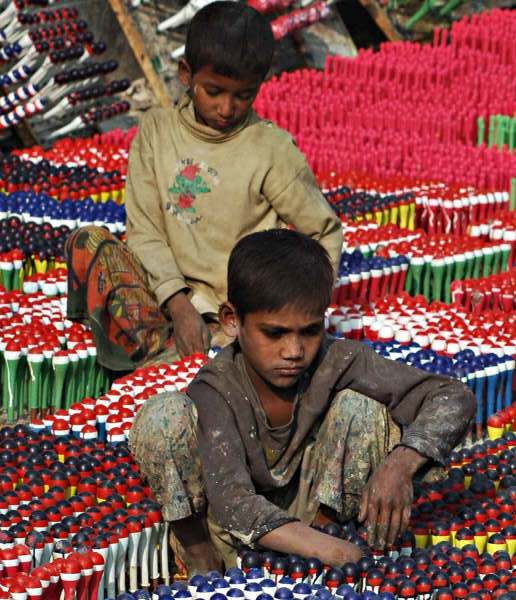Shillon Mia, 9, works as a lathe machine assistant at a garage in Chuadanga town, 150km from Dhaka. "I get three meals a day here, plus 20 taka [US 30c] a week," he said.
His father, Hayat Mia, 30, used to draw a pushcart in Chuadanga town. His mother Shahana Begum, 25, works as a domestic help. Shillon used to go to the free government primary school but when Hayat Mia had to have surgery for a stomach tumour, the family's finances were decimated.
"With rice selling at 35 taka/kg [51 cents], Shillon is better off at work than at home. The 300 taka [$4.40] I earn is our only income. His employers keep me free from worries about his food," said Shahana.
"I enjoy going to school, but can't. I have to earn money for my family. I will go to school again after my father recovers," said Shillon.
Shillon is just one of the estimated 7.9 million working children in Bangladesh, of whom 6.4 million are rural and 1.5 million urban; 1.4 million of them are engaged in hazardous jobs. Many of these children work for little or no pay.
They represent 16.6 percent of the total workforce in the country, working eight to 12 hours a day, mostly in difficult conditions. (National Child Labour Survey 2002-2003; Bangladesh Bureau of Statistics)
"With very poor or no education, child workers become trapped in the cycle of low skills, low income and low education that further pushes them into the vicious cycle of inter-generational poverty," said Ridwanul Haq of Dhaka University.
National policy
Labour and Employment Adviser Anwarul Iqbal said a draft National Child Labour Policy, vetted by employers, workers, NGOs, donors, development partners and other stakeholders, would soon be presented to the government's Council of Advisers.
 Photo: Shamsuddin Ahmed/IRIN  |
| A young girl sells mineral water under the scorching sun in Dhaka |
"We have nearly completed the work to finalise the national policy on the elimination of child labour. It would have been great if we could have announced the policy on 12 June, the international day to prevent child labour, but we will do it within one month," said Labour and Employment Secretary Mahfuzul Haque on 11 June.
He said the policy would be a guideline on eliminating child labour, and it would be modified phase by phase through talks with stakeholders.
"In a country like Bangladesh, it is impossible to eliminate child labour under any short-term measure," said Khurshid-ul Alam, executive director of Bangladesh Bank, noting that most families survive on their children's incomes.
"If we take them away from their jobs, we would directly contribute to the hunger and desperation of their families," he warned.
He recommended that the government, donors and NGOs initially take measures to rehabilitate only those children engaged in hazardous work.
"Then we can move to subsequent phases of eliminating child labour through providing life skills training and proper education to the working children," he said.
Skills development
The government's Eradication of Hazardous Child Labour Project, funded by the Swedish and Canadian governments, aims at withdrawing 30,000 child labourers from hazardous jobs through two-year, non-formal education, and six-month skills development programmes. It is also providing micro-credit to 20,000 parents of child labourers. Some 76 NGOs are working on the project.
Shamsul Alam, director of the project, said removing child labour in the socio-economic context of the country was no easy task. "All must work together to fight it," he said.
 Photo: Shamsuddin Ahmed/IRIN  |
| A young girl helps her mother boil newly harvested paddy. The vast majority of working children are in rural Bangladesh |
In the first phase of the project, 11,550 centres nationwide offered two-year courses to 339,150 working children aged eight to 14. Classes were held in two shifts to accommodate the children's work schedules, with a maximum of 30 students per class. Learning materials were provided, and there was no homework involved.
Phase two, to 2009, aims to withdraw 30,000 child labourers from hazardous jobs through a two-year non-formal education and six-month skill development programmes. It also provides micro-credit to parents.
The second phase of the project targets 10-14-year-olds, who are even less likely to return to mainstream education.
The basic education course, which allows students to reach an equivalent of grade three, has been extended to 40 months from the earlier two-year programme. Priority has been given to vocational training. The project will then assist the children with job placements, or self-employment, and follow up on their needs for six months.
sa/mw
This article was produced by IRIN News while it was part of the United Nations Office for the Coordination of Humanitarian Affairs. Please send queries on copyright or liability to the UN. For more information: https://shop.un.org/rights-permissions





